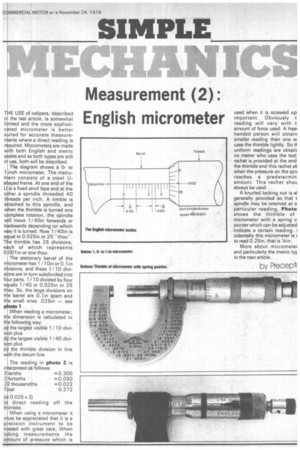Measurement (2): English micrometer
Page 45

If you've noticed an error in this article please click here to report it so we can fix it.
THE USE of calipers, described Id the last article, is somewhat linited and the more sophistic ted micrometer is better suited for accurate measure
ents where a direct reading is r quired. Micrometers are made ith both English and metric ales and as both types are still use, both will be described. The diagram shows a 0to 1 inch micrometer. The instruent consists of a steel U
s aped frame. At one end of the U is a fixed anvil face and at the o her a spindle threaded 40 t reads per inch. A timble is a tached to this spindle, and When the thimble is turned one complete rotation, the spindle will move 1/40in forwards or backwards depending on which way it is turned. Now 1/40in is equal to 0.025in or 25 "thou". The thimble has 25 divisions, each of which represents 6001 in or one thou.
The stationary barrel of the micrometer has 1/10in or 0.1 in divisions, and these 1/10 divisiOns are in turn subdivided into fcrur parts. 1/10 divided by four equals 1/40 or 0.025in or 25 thou. So, the large divisions on the barrel are Olin apart and the small ones .025in — see photo 1 When reading a micrometer, the dimension is calculated in the following way: (a the largest visible 1/10 division plus (b) the largest visible 1/40 division plus (c) the thimble division in line with the datum line 2 fortieths 2 thousandths tal =0.300 =0.050 =0.022 0.372 (ie 0.025 x 2) (a direct reading off the thimble).
When using a micrometer it must be appreciated that it is a p-ecision instrument to be treated with great care. When taking measurements the amount of pressure which is used when it is screwed up important. Obviously t reading will vary with t amount of force used. A hea) handed person will obtain smaller reading than one w uses the thimble lightly. So tt: uniform readings are obtain no matter who uses the tool rachet is provided at the end the thimble and this rachet sli when the pressure on the son reaches a predetermin amount. This rachet shou always be used.
A knurled locking nut is al generally provided so that t spindle may be retained at o particular reading. Photo shows the thimble of micrometer with a spring c pointer which can be adjusted indicate a certain reading. I cidentally this micrometer is to read 0.25in, that is 1/4in.
More about micrometer and particularly the metric tyr in the next article.
by Precept(








































































































































